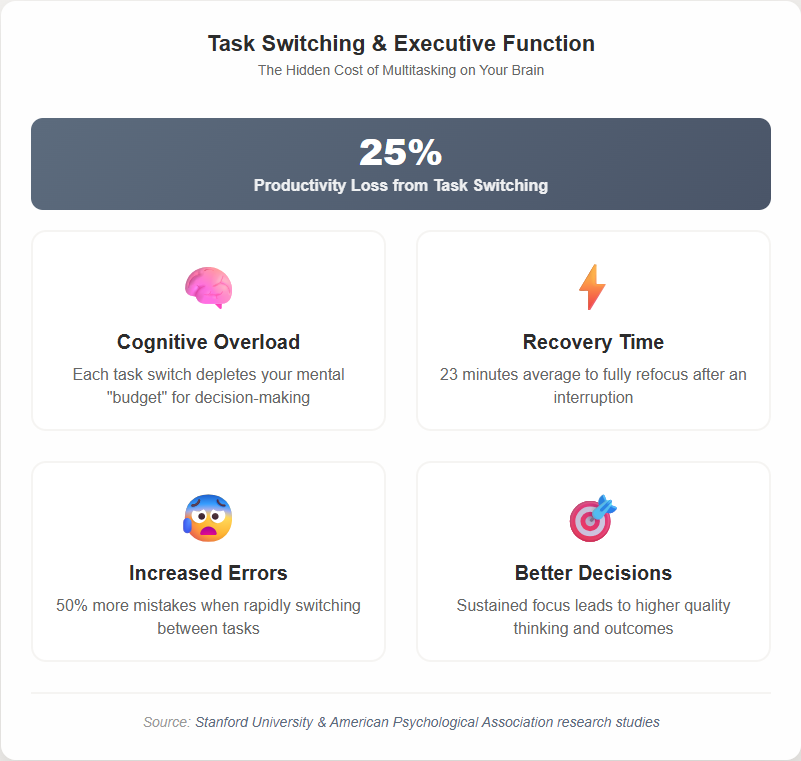It’s Monday morning and your to-do list is as long as your arm. You’re settling into a Zoom meeting, but your eyes keep drifting to the email notifications pinging in the corner of your screen. Your teen just texted about needing lunch money. That “urgent” Slack message from Friday is still nagging at you.
I’m not leading this meeting, you think. It’s fine if I just respond to this one email and give a thumbs up to that text.

We’ve all been there. Most of us have no fewer than three devices at our desk—laptop, phone, maybe a tablet, possibly even that landline that somehow still exists. The temptation to multitask feels not just reasonable, but necessary. After all, if you’re not actively speaking, you’re not really needed, right?
Wrong. And according to research from Stanford University, this habit wreaks havoc on our productivity—and I’d argue, our peace of mind.
The idea of bringing a mobile device into a meeting 15 years ago would have been unheard of. But since the iPhone launched in 2007, we’ve all been “connected” 24/7. With this new level of accessibility came an unspoken expectation—we should always be available, always responsive, always on.
The trouble is, this leads to burnout, mistakes, and those rash, sometimes emotional responses we later regret. Being thoughtful takes time. It’s not instant, and it shouldn’t be. You need context, time to consider the information being shared, and space to determine whether it matters to you and how—or if—you should respond.
But here’s what’s really happening: when we split our attention, dividing it among multiple tasks, nothing gets our undivided attention. No one benefits from the full potential of what we bring to the table. The meeting suffers. The email gets a hasty response. The text goes unanswered anyway because we got distracted by something else entirely.
And the cost? It’s bigger than you think.
Meeting fatigue became a real crisis following the pandemic, when we went from spending a few hours in front of our screens to having every single interaction become a Zoom meeting. Research published in Applied Psychology confirmed what we all suspected: video conferences are more exhausting than meetings held through other media. But the problem runs deeper than screen time. Meetings that lack clear focus, meetings that should have been well-crafted emails, meetings where no one comes prepared—these waste time, cost organizations money, and drag out decision-making processes that should be swift and decisive.

And here’s the worst part: when no one is running the meeting, no one is running the meeting. It becomes a purgatory of inaction and indecision. In environments like small businesses and nonprofits, indecision can kill budgets, derail timelines, blow up project scope—you name it.
As I’ve said before and will continue to say: time is our only currency. We shouldn’t waste our time or that of others. But that’s exactly what happens when we show up unprepared, unfocused, and unavailable—even when we’re physically present.
Here’s what’s actually happening in your brain when you try to multitask: you’re not really doing multiple things at once. You’re rapidly switching between tasks, and each switch depletes your executive function—your brain’s management system that handles decision-making, problem-solving, and focus.
Think of executive function like a daily account balance. Every time you toggle between your email and the meeting, check your phone and refocus on the speaker, or mentally compose a response while someone else is talking, you’re making a withdrawal. By mid-morning, you’re operating with a negative balance, making decisions while you’re overdrawn.

This is especially important to understand because not everyone processes information the same way. Some team members—including many neurodivergent folks—need more time to absorb and process information. If you’re familiar with DiSC communication styles, you know that people with S (Steadiness) and C (Conscientiousness) styles often do their best thinking when they can review materials beforehand, not when they’re put on the spot in a meeting.
When we operate in constant multitasking mode or show up unprepared, we’re not just being inefficient—we’re systematically shutting out the people who could provide the most thoughtful, thorough input. We’re leaving value on the table.
A Matter of Investment and Respect
If we reframe how we think about meetings—both in-person and virtual—we start to put more stock in the time dedicated for connection. Blocking out your calendar, being away from your home or your team, giving your attention to a shared goal—these are all sacrifices that deserve respect.

There’s nothing worse than arriving late to a meeting and making others wait for you, being unprepared and asking others to catch you up, or following up afterward with questions that could and should have been addressed in real time—if only you’d been present enough to ask them.
When someone schedules time with you, they’re not just “hopping on a Zoom.” They’ve set aside time specifically for you, for this conversation, for this shared work. Respect that.
Taking Back Control: Practical Solutions That Actually Work
The good news? Small changes can make a dramatic difference. Here’s how to shift from reactive to thoughtful, from scattered to strategic:
Before the meeting: Send materials ahead of time and include a clear agenda. This isn’t just good practice—it’s inclusive leadership. Give people time to process, especially those who do their best thinking outside the pressure of real-time discussion.
During the meeting: Put your phone in your bag. Close your email. Make eye contact. If you’re leading the meeting, actually lead it—set the tone by being fully present yourself. Take breaks when you need them. Get up, grab water, give your brain a moment to reset.
Show up prepared and on time. This seems basic, but it’s become surprisingly rare. Being punctual and ready demonstrates that you value others’ time as much as your own.
Time-block your email review instead of letting notifications control your day. Decide when you’ll engage with messages rather than giving that power to every ping and buzz. It’s the difference between being proactive and reactive, between being thoughtful and strategic versus… everything else.
If you’re a leader, hold yourself especially accountable. Your attention habits set the tone for your entire organization. When you model presence, you give others permission to do the same.
The Beautiful Thing About Presence
Here’s the fun part: this works at home just as well as it works at work. When you sit and actually listen to your family instead of rushing to cook dinner, feed the dog, and tidy up simultaneously, you give them your attention and respect. You’re more likely to fully comprehend the conversation, to catch the nuance that matters, to respond thoughtfully instead of reactively.

Your brain craves this kind of quiet focus. Think about how much clearer you think without distraction—after a calming walk, a meditation session, or a good night’s rest. Something beautiful happens when we give our minds space to do what they do best.
Words matter. Time matters. We can show each other that by being present—or at least attempting to be more present.
In a world where everyone is perpetually connected, perpetually available, and perpetually scattered, full attention has become a rare gift. When you give it consistently, you’ll discover that presence isn’t just polite—it’s powerful. It’s a competitive advantage disguised as good manners.
The next time you’re in a meeting, resist the urge to multitask. Put the phone away. Look up from the screen. Be here, be now, be present.
Your colleagues, your organization, and your own peace of mind will thank you for it.
Let’s stay present and focus on what matters most, together. Subscribe to Notes from The Perch for insights delivered at your preferred frequency—twice monthly, monthly, or quarterly.
External Sources:
Leave a Reply